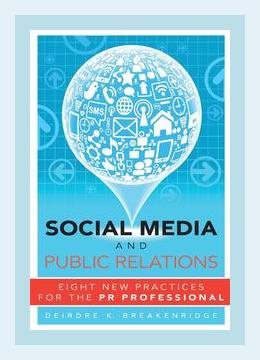Marketing and SalesPublic Relations
Book Summary: Social Media and Public Relations: Eight New Practices for the PR Professional by Deirdre K. Breakenridge (2012)
Introduction
Deirdre K. Breakenridge’s book, “Social Media and Public Relations: Eight New Practices for the PR Professional,” aims to address the evolving role of public relations (PR) in the digital age. With the advent of social media, the responsibilities, strategies, and skill sets of PR professionals have drastically transformed. Breakenridge identifies eight new practices that PR practitioners should adopt to stay competitive and effective. This summary will explore these practices, provide concrete examples from the book, and recommend specific actions that professionals can take based on Breakenridge’s advice.
1. The PR Policymaker
Major Points:
The PR Policymaker is a strategic thinker who develops guidelines for social media use within an organization. This role ensures that all communication aligns with the company’s mission, values, and strategic objectives.
Examples in the Book:
Breakenridge stresses the importance of creating comprehensive social media policies to avoid PR crises. For instance, she discusses a case where a well-defined policy helped an organization navigate a social media backlash by ensuring all staff adhered to pre-established guidelines.
Action Step:
Draft a social media policy document that outlines acceptable content, tone, and frequency of posts. Engage with legal, HR, and marketing departments to ensure the policy is robust and covers all necessary aspects.
2. The Internal Collaboration Generator
Major Points:
This practice emphasizes fostering collaborative environments within an organization. PR professionals must break down silos and work across various departments to synchronize messaging and strategy.
Examples in the Book:
Breakenridge mentions a company that achieved success by creating inter-departmental task forces focused on consistent social media messaging. This led to a more unified public image and efficient resource use.
Action Step:
Organize regular cross-departmental meetings to discuss social media strategies, share content ideas, and ensure that all departments are on the same page regarding brand messaging.
3. The Comms Organizer
Major Points:
The Comms Organizer ensures that all communication efforts—both internal and external—are organized and systematic. This involves using management tools to schedule posts, track conversations, and measure engagement.
Examples in the Book:
She provides an example of a company utilizing social media management tools such as Hootsuite and Buffer to synchronize their posting schedules, track real-time engagement, and analyze data for future planning.
Action Step:
Implement a social media management tool and establish a content calendar. Regularly review analytics to fine-tune future content based on what resonates best with your audience.
4. The Pre-Crisis Doctor
Major Points:
This role involves identifying potential crises before they escalate. The Pre-Crisis Doctor monitors social channels, analyzes sentiment, and develops response strategies for various scenarios.
Examples in the Book:
Breakenridge discusses how an early detection system helped a company neutralize a negative trend on Twitter by addressing the issue promptly and transparently.
Action Step:
Set up social listening tools to monitor brand mentions and sentiment. Develop a crisis management plan that includes predefined responses and an escalation protocol.
5. The Relationship Analyzer
Major Points:
The Relationship Analyzer focuses on understanding and analyzing relationships with stakeholders. This involves using analytics to gauge the strength and quality of these relationships.
Examples in the Book:
The book explains how one organization segmented its audience based on engagement levels and tailored its communication strategies to nurture these relationships more effectively.
Action Step:
Segment your audience based on interaction data—such as likes, shares, and comments—and develop personalized strategies to enhance engagement and foster strong relationships.
6. The Reputation Task Force Member
Major Points:
PR professionals in this role are responsible for monitoring and managing the organization’s reputation. This involves quickly addressing misinformation and ensuring positive brand perception.
Examples in the Book:
Breakenridge cites a case where a company’s proactive response to a false rumor circulating on social media helped maintain its reputation and even earned praise from the public for transparency.
Action Step:
Monitor online conversations about your brand actively. Have a dedicated team to address misinformation rapidly and transparently.
7. The Master of the Metrics
Major Points:
The Master of the Metrics role requires PR professionals to be adept at using data analytics to measure the effectiveness of their campaigns. This involves setting KPIs and continuously refining strategies based on data.
Examples in the Book:
Breakenridge highlights a instance where a company used detailed social media analytics to discern which types of content garnered the most positive engagement, thereby optimizing their content strategy.
Action Step:
Identify key performance indicators (KPIs) relevant to your objectives and use analytics tools to track these metrics. Adjust your strategies based on the insights gained from the data.
8. The Lead Training Manager
Major Points:
The Lead Training Manager focuses on educating and training the organization’s staff on social media best practices. This ensures that everyone represents the brand consistently and positively online.
Examples in the Book:
A company is discussed where regular social media training sessions significantly improved overall employee advocacy and brand representation.
Action Step:
Develop a training program that educates employees on effective social media use, brand guidelines, and the importance of online reputation management. Schedule regular refresher courses to keep everyone updated on new practices and tools.
Conclusion
Deirdre K. Breakenridge’s “Social Media and Public Relations: Eight New Practices for the PR Professional” offers an invaluable framework for PR practitioners navigating the complexities of the social media landscape. Each of the eight practices outlined provides detailed, actionable steps that can be implemented to improve communication strategies, foster better internal collaboration, and enhance reputation management.
Adopting these practices requires a proactive approach, a willingness to leverage data and technology, and a continuous commitment to learning and adapting. By adhering to these principles, PR professionals can ensure they stay relevant and effective in an ever-evolving digital world.
This summary incorporates a diverse range of examples and actionable steps for each of the major points outlined in the book, aiming to provide a comprehensive understanding of the eight new practices recommended by Breakenridge.
